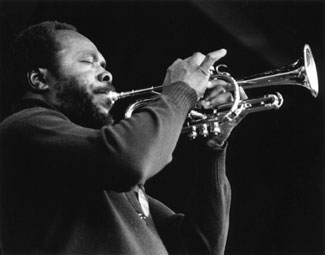
Jones had to fight hard to get his arrangements recorded by Basie in the 1950s. While Jones showed early promise as an arranger and he recorded as a leader of small groups separately from Basie, he was up against stiff writing competition in the Basie band. Basie's crew of swinging freelance and in-house arrangers in the 1950s included Neal Hefti, Frank Foster, Frank Wess, Ernie Wilkins and Nat Pierce. Each of these heavyweights wrote muscular charts that weaved and bobbed, delivering call-and-response section jabs and typically ending with an enormous build and explosive wrap-up. It was tough for Jones to beat out these penmen for a place on the music stand.
Then in 1958, Jones' signature sound began to find its way onto Basie's recordings. The reason for the change likely was extended touring and performing, and a greater demand for varied instrumental material in the new stereo age. The first Basie album with full-blown Jones charts was Chairman of the Board (Roulette). On this 10-track album, Jones arranged H.R.H. (Her Royal Highness), Speaking of Sounds, The Deacon and Mutt & Jeff. Each arrangement has a parfait-porterhouse dichotomy, shifting effortlessly from a light, wispy feel with flute added to a bedrock bottom driven by trombones and reeds. In some cases, these two different feels were handsomely merged with breathtaking results.
Jones was in fast company. The album's other tracks were arranged by Foster [pictured], Wess and Wilkins--and all were stellar contributions. For example, Foster's Blues in Hoss' Flat is on here. But if you just listen to the Jones tracks, a funny thing happens. You hear how advanced his writing was in the late 1950s and how little the arrangements and instrument textures relied on traditional Basie tricks.On Jones' H.R.H., a regal blues written in 1957 for Queen Elizabeth during the Basie band's trip to London, Jones builds with aromatic finger-snapping textures, pitting the trumpets against the trombones and saxes, getting the trombones to sound almost like French horns.
Speaking of Sounds opens with guitarist Freddie Green playing what sounds like a maraca. Then the band joins in, and there's that Jones' cats-feet sound again--like someone arriving home late with shoes in hand. The intricate lines here make everyone in the band sound vital to the end result.The Deacon is a medium-tempo blues that kicks off with a Li'l Darlin'-inspired series of piano chords. Basie then runs through a piano solo, interrupted by the band's stealthy gospel line, featuring hiccupped call-and-response figures.
Mutt & Jeff is perhaps Jones' strongest chart on the album. At the start, Jones pairs Eddie Jones' bass with Frank Wess' flute. As the pair play in tandem, the duet is joined by muted trumpets and trombones, which Jones somehow managed to arrange like strings. The high point comes at 2:47 into the track, where Jones wrote these swirling lines for the saxes. Listen how complex they are in the swing idiom, yet they never bog down or seem excessive.
For perspective on Jones, I gave Benny Powell a call yesterday. Benny, who played in Basie's band throughout the 1950s and early 1960s, was in the middle of practicing but graciously put down his horn for five minutes to reflect on Jones' arrangements [Photo of Benny Powell by Ed Berger]:
“Thad was about sophistication and sanctification. He had a sanctified mindset but his approach was sophisticated in terms of his theoretical knowledge and how he managed to get both of these qualities out of his music.
“I remember when I first moved to California and worked in Gerald Wilson's band. He asked me the same thing about Thad and his arrangements. Gerald wanted to know what I thought made them so special and so much fun to play. I loved Thad's work. Thad had a thing that was church, but it more organized and refined than just gospel.
“Did I get chills when I was with Basie and saw a Thad Jones arrangement on the music stand? Not when I saw it--when I heard it [laughs]. Thad had a way of writing double-time for the reed section that knocked me out.
“You see, deep down, Thad's thing was all about happiness. When he'd conduct the band, his body language got everyone going. He had a way of shaping his hand like a brick and showing you what he wanted with subtle movements of his fingers. He was one of the most amazing conductors. Thad was effervescent. He could tell you what he wanted with sign language. And he got everyone to feel the way he felt. Jimmy Heath is like that, too.
“But before the conducting, Thad had built that 'up' feeling of his into the music. Thad could write parts for individual musicians that made them feel as though they were the most important instruments in the band. You could distinctly hear your single contribution to the arrangements. For example, if you played third trombone, as I did, you felt you had a major part in a Thad Jones arrangement, even if what you were playing had nothing to do with the song's melody line.
“Thad's music was very sophisticated. And sometimes it was dissonant. But no matter, it always made perfect sense, especially to the musicians playing it."
JazzWax tracks: Count Basie's Chairman of the Board can be found at iTunes or here. This 1958 album has long been overshadowed by Basie = MC2, also known as Atomic Basie, which was recorded in October 1957. The static cover for Chairman of the Board, featuring Basie and band members sitting passively in a conference room, didn't help much either. But when you give this neglected album a fresh listen, you'll hear just how exciting Basie's band was on the Roulette label. You'll also hear one of Basie's newest arrangers--Thad Jones. Dynamic stuff.
This story appears courtesy of JazzWax by Marc Myers.
Copyright © 2024. All rights reserved.



























